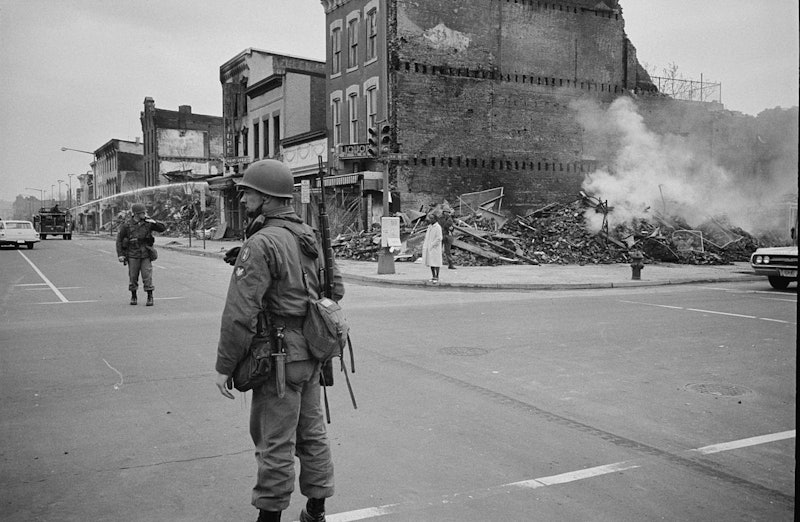News
The Baltimore Riots Evoke Memories Of 1968

Despite the presence of relatively peaceful protests in Baltimore this week, on Monday night, the city had been overrun by what local police claimed was a group of 100 or so students from a nearby high school, looking to throw the neighborhood into chaos. By the evening, the reigning calm had been replaced by a frenzied scene of looters and rioters who smashed windows, poured into bank lobbies, and destroyed police vehicles in alleged retribution for the death of local man Freddie Gray, who died while in police custody. For all intents and purposes, the protest was over. For some, the Baltimore riots evoked memories of a similar 1968 backlash after the assassination of civil rights leader, Dr. Martin Luther King Jr., calling to mind the dark hours in which six citizens died and more than 700 were injured.
"We can not go back to 1968 where we burned down our own infrastructure and our own neighborhoods," City Council President Jack Young told CBS reporters on Monday, pleading with those involved to "stop the madness." "We still have scars from 1968 ... in the end it hurts us as a people." Young lamented that the whole world was watching the chaos and that the rioters gave the rest of the protesters a bad name.
On April 5, 1968, one day after Dr. King's assassination, the city of Baltimore stood on the precipice of widespread demonstrations, similar to those occurring in neighboring Washington, D.C. By mid-afternoon on April 6, following King's memorial service, citizens began lining the streets, rallying their numbers in protest of racial inequality and impoverished and brutal living conditions.
Government records at the time indicated that a teetering culture of "failure and frustration" dominated the low-income portions of the city, a warning that was largely ignored as the Vietnam War began smothering the headlines, reported Think Progress. The burden of both economic and social injustice had begun to topple, and by the evening of April 6, a steady stream of angry riots had broken out, prompting National Guard troops and local police to issue a curfew and ban the sale of alcohol.
By dawn on April 7, the full scale of the damage was visible: Smoke from 300 separate fires and shattered glass from looted storefronts and businesses gave the city a ghostly post-apocalyptic feel as the clamor from the previous day began winding down. Elizabeth Nix, assistant professor in the Division of Legal, Ethical and Historical Studies at University of Baltimore, explained to Slate on Tuesday that rioters had largely targeted specific types of businesses in their anger as well:
...They went after three types of stores: liquor stores, dry cleaners, and pharmacies. ... Dry cleaners had a practice where if you didn’t pay your dry cleaning bill, they would sell your clothes. And there was a whole credit system in place — it was hard for a lot of people living in those neighborhoods to do business with regular banks, and that was part of the institutional racism that was operating in this town. ... And so that was one reason that resentment built up against the dry cleaners — because of that practice. Corner stores also had credit systems. ... So there were some corner stores that were hit [too].
President Lyndon Johnson at the time described the violent riots as unsurprising.
What did you expect? I don’t know why we’re so surprised. When you put your foot on a man’s neck and hold him down for three hundred years, and then you let him up, what’s he going to do? He’s going to knock your block off.
"The perception of Baltimore that outsiders had — that Baltimore was a dangerous place, that it was a place where you’d never want to live — that was an effect of the uprisings of 1968," explained Nix. "That, more than the physical damage, had a huge effect on Baltimore for decades." Nix worried that the image of Baltimore now, as an unstable community, could hamper future efforts to rebuild economically and socially.
"I do believe that the city recovered from the riots, [but] the city did not recover from the underlying trends that led to the riots," Nix told Bustle on Tuesday, explaining that "unemployment and under-employment, institutional racism, decades of public policies that encouraged highways to cut through some communities and isolate others from the city" kept many areas of the city of Baltimore segregated, leading to longstanding generations of poverty. "Those conditions still exist in some of the same neighborhoods that erupted in 1968 and that saw unrest again last night," said Nix.
As clean-up begins and tensions in the city remain palpable, despite the quell in activity, Baltimore residents have been forced to relive the damage done nearly 50 years earlier.
"I just came to show my son what happened when you're mad and you go about it the wrong way," said Imani Rose, who brought her 9-year-old to the scene of Monday's riots, in a comment to The Baltimore Sun. As her son surveyed the charred structures, he asked why the people had damaged the property.
"They got mad," replied Rose. "You can be angry and upset but you don’t tear up people’s things."
Images: Library of Congress (2); Getty Images (1)